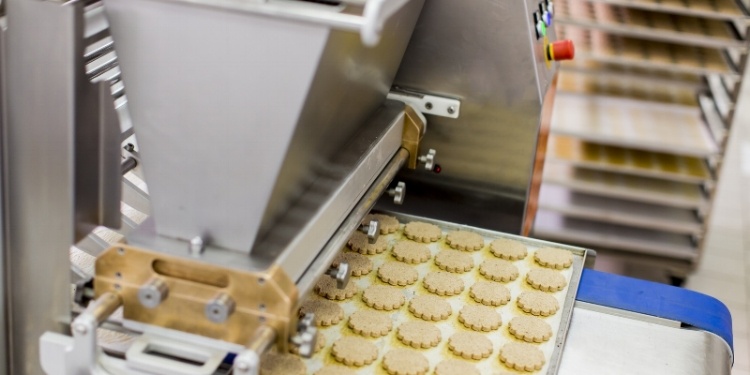
Ask anyone who’s ever had food poisoning and they can tell you it’s not pleasant, and that’s being polite. Food safety is so important that a staggering 15 agencies monitor food safety in the U.S., though the bulk of the regulatory work falls on the Food and Drug Administration (FDA) and United States Department of Agriculture (USDA). Those agencies ensure that food manufacturers in the U.S. monitor and maintain high levels of safety and hygiene to prevent product contamination.
Similarly, the vendors that supply food manufacturers with equipment and tools, like Marlin Steel, need to make sure their equipment will contribute to and facilitate the adherence to those food safety regulations. In short, the food production and manufacturing industry relies on qualities of food grade stainless steel to ensure food safety and hygiene standards are met.
Quick Links- What is Stainless Steel and Why is it Used in the Food Industry?
- Food Grade Stainless Steel 316
- Grade 430 Stainless Steel and Food
- Which is Best for Food-Safe Applications?
What is Stainless Steel and Why is it Used in the Food Industry?
Stainless steel refers to specific iron-based alloys with a minimum of 11% chromium. The alloy includes other metals, specifically nickel, and other elements like carbon. It’s the specific, and varied, elemental makeup that gives stainless steel the properties that make it valuable in multiple industries, particularly those where the metal will be exposed to harsh or difficult environmental situations.
Specifically, in the food industry, stainless steel is exposed to heat, water, and harsh cleaning chemicals. Through those exposures, food grade stainless steel must remain durable, rust/corrosion free, and be easy to sanitize. Further, the pitting resistance means it maintains a surface that’s easy to clean and maintain. Finally, the heat resistance of the metal means it can be exposed to extreme temperatures without risking damage.
For those reasons, many food makers use stainless steel metal trays in their food-making processes. However, what some might not realize is that not just any type of stainless steel will do. There are hundreds of different varieties of stainless steel on the market, each one with its own unique combination of properties.
Which stainless steel is best depends on the specific application. For example, a confectioner manufacturing chocolates is going to have very different performance needs than a processor specializing in tomato sauce.
Food Grade Stainless Steel 316
Grade 316 stainless is an austenitic stainless steel alloy with a high chromium and nickel content. Like many steel alloys, it has a continuous use temperature several times higher than most food making processes will ever require (more than 800°C, or 1472°F).
What makes the grade 316 alloy an ideal food grade steel sheet material is the fact that it has a high resistance to acids, alkalis, and chlorides (such as salt). Other austenitic stainless steels, such as grade 304 SS, can experience severe pitting corrosion when exposed to salt, which is often present in food products.
316 makes for great food grade stainless steel containers for nearly any food application.
Grade 430 Stainless Steel and Food
As an alloy, stainless steel 430 food grade metal is very similar to grade 316 stainless. It has the same chromium content as 316, but only a fraction of the nickel content, which makes it a more affordable alternative for some food makers.
Another major difference between 430 and 316 stainless steel is that grade 430 SS is a ferritic alloy, meaning that it’s magnetic by default. Ferritic alloys like 430 SS also have extraordinary resistance to stress corrosion cracking (the growth of crack formations that can cause sudden failure in corrosive environments).
430 SS has a strong resistance to nitric & organic acids and is often used for applications where prolonged contact with mildly acidic compounds is a concern. The alloy also boasts a resistance to sulfur and oxidation.
However, because of the low nickel content, this alloy is not as resistant to some dilute reducing acids as grade 316 stainless steel would be.
Which is Best for Food-Safe Applications?
Overall, grade 316 is usually the better choice when making food-grade stainless steel containers. 316 SS is more chemically-resistant in a variety of applications, and especially when dealing with salt and stronger acidic compounds such as lemon or tomato juice.
However, 430 is a good, lower-cost alternative for food makers that need a moderately resistant, food grade steel sheet for their manufacturing process.
It’s important to note that the resistance properties of both alloys can be enhanced via electropolishing. This process not only improves the oxide layer that protects the steel, it removes microscopic peaks and valleys on the alloy’s surface, making it harder for food to stick to the steel and easier to clean.
However, it’s also important to note that maintenance of a custom stainless steel tray or basket plays a huge role in prolonging its useful life. For example, stainless steel sheet metal should never be scrubbed using a plain steel or iron brush, as this may transfer iron particles onto the surface of the stainless and compromise its protective oxide layer.
With the right stainless steel alloy, you’ll have a metal tray or basket that will boost your productivity for years to come. Need a custom metal form for your food production process? Contact Marlin Steel for a food grade metal tray or basket quote today!


.png)






.gif)


